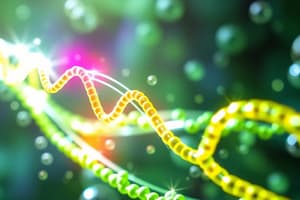Podcast
Questions and Answers
What is the primary function of ATP in chemical work?
What is the primary function of ATP in chemical work?
- Facilitating muscle contraction
- Building macromolecules (correct)
- Assisting in DNA replication
- Transporting ions across membranes
Which cellular processes require a steady supply of energy?
Which cellular processes require a steady supply of energy?
- Flagellum movement and ion transportation
- Protein synthesis and cilia movement (correct)
- Transcription and translation
- DNA replication and muscle contraction
What is the role of NADPH in cellular reactions?
What is the role of NADPH in cellular reactions?
- Gaining electrons in reduction reactions (correct)
- Assisting in DNA replication
- Facilitating muscle contraction
- Losing electrons in oxidation reactions
What is the original meaning of 'reduction' in the context of redox reactions?
What is the original meaning of 'reduction' in the context of redox reactions?
Which type of work in the cell involves ATP for muscle contraction and cilia movement?
Which type of work in the cell involves ATP for muscle contraction and cilia movement?
What is the function of ADP + Pi in relation to ATP?
What is the function of ADP + Pi in relation to ATP?
What is the main function of NADPH?
What is the main function of NADPH?
What is the role of ATP synthase in the cell?
What is the role of ATP synthase in the cell?
Which process involves the addition of a water molecule to break the phosphoanhydride bonds in ATP?
Which process involves the addition of a water molecule to break the phosphoanhydride bonds in ATP?
What occurs when a phosphate bond in ATP is broken?
What occurs when a phosphate bond in ATP is broken?
Which molecule contains high-energy phosphate bonds that store and release energy?
Which molecule contains high-energy phosphate bonds that store and release energy?
What is the main function of Adenosine Monophosphate (AMP)?
What is the main function of Adenosine Monophosphate (AMP)?
What type of reaction is Endergonic?
What type of reaction is Endergonic?
What occurs when any of the phosphate bonds in ATP are broken or formed?
What occurs when any of the phosphate bonds in ATP are broken or formed?
Flashcards are hidden until you start studying
Study Notes
Energy and ATP
- ATP (Adenosine Triphosphate) is the primary energy currency of the cell, providing energy for various cellular processes.
- Cellular processes that require a steady supply of energy include muscle contraction, cilia movement, and biosynthesis.
Redox Reactions and NADPH
- NADPH (Nicotinamide adenine dinucleotide phosphate) is a reducing agent that plays a crucial role in cellular reactions, particularly in anabolic pathways.
- The original meaning of 'reduction' in the context of redox reactions refers to the gain of electrons.
ATP Synthesis and Hydrolysis
- ATP synthase is an enzyme that generates ATP from ADP and Pi (inorganic phosphate) during oxidative phosphorylation.
- The addition of a water molecule to break the phosphoanhydride bonds in ATP is known as hydrolysis.
- When a phosphate bond in ATP is broken, energy is released and can be utilized by the cell.
Energy Storage and Release
- ATP contains high-energy phosphate bonds that store and release energy as needed by the cell.
- When any of the phosphate bonds in ATP are broken or formed, energy is either released or stored.
Nucleotides and Endergonic Reactions
- Adenosine Monophosphate (AMP) is a nucleotide that plays a role in energy signaling and metabolism.
- Endergonic reactions are chemical reactions that require energy input, often in the form of ATP.
Studying That Suits You
Use AI to generate personalized quizzes and flashcards to suit your learning preferences.




